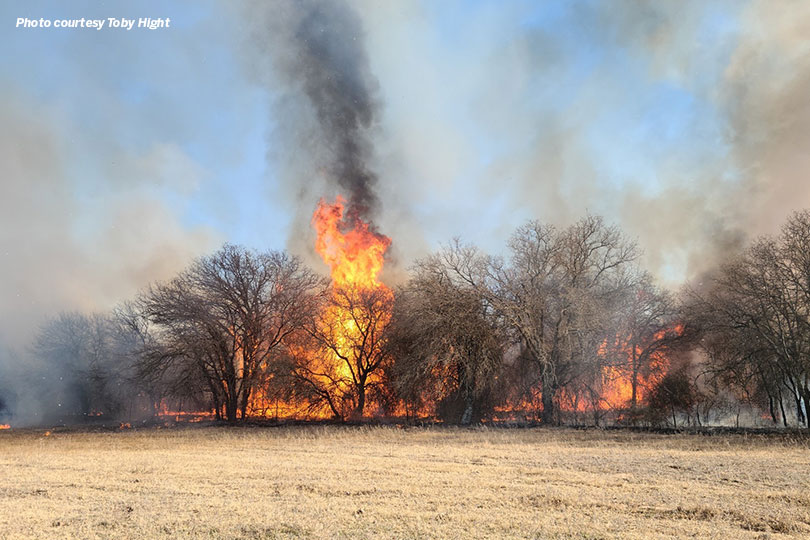By Julie Tomascik
Editor
Wildfires have swept across Central and West Texas this month, burning over 86,000 acres. Some of those fires are still not fully contained.
The damage from the burning fires sparked Gov. Greg Abbott to issue a disaster declaration for 15 counties.
Those counties include Brooks, Brown, Coleman, Comanche, Eastland, Grayson, Mason, Potter, Randall, Williamson, Blanco, Erath, Hood, Runnels and Starr.
In an effort to help farmers and ranchers impacted, Texas Farm Bureau (TFB) established the West Texas Wildfire Relief Fund.
“Although we don’t know the full extent of the damage caused by the fires, we do know the losses will be staggering,” TFB President Russell Boening said. “Farm Bureau members have always stepped up to help their neighbors in need, and this wildfire relief fund will collect tax-deductible donations to meet the needs in affected areas.”
The program will collect and distribute monetary contributions only.
TFB will match 50% of any donation to the West Texas Wildfire Relief Fund made by a county Farm Bureau up to $2,000.
Other efforts are ongoing by various organizations to collect donations of hay, feed and fencing supplies for those impacted by the fires.
Burning situation
Fueled by dry, windy conditions, the fires swept across Texas in March.
The Eastland Complex wildfires consisted of seven fires and spanned more than 54,000 acres.
It was considered a Southern Plains Wildfire Outbreak (SPWO) and began on March 17. This event supported rapid growth and extreme fire behavior in Eastland County.
SPWO events, according to the Texas A&M Forest Service, have caused some of the most destructive wildfires in Texas history. While SPWO fires account for 3% of reported wildfires, Texas A&M Forest Service officials noted they account for 49% of the acres burned.
SPWO events are extremely dangerous fire weather phenomenon characterized by an environment of dry vegetation, dry west-southwest winds across an area with low relative humidity, above average surface temperatures, an unstable atmosphere and clear, sunny skies.
Another SPWO fire was the Perryton fire located in the Texas Panhandle in 2017 that burned 318,156 acres.
Fires also burned in West Texas, devouring acres of pastureland and farmland, as well as livestock, homes, barns and equipment.
Farmers and ranchers sprang into action—moving cattle, packing up families and building fire breaks. They worked alongside state agencies to try to contain the fires.
“During this tragedy, we saw neighbors helping neighbors, lending trailers to haul livestock and housing livestock, horses and pets,” Boening said. “Texas is doing what Texas does best—helping one another, and Farm Bureau is doing its part, too.”
Some rain has since fallen, helping the charred countryside begin to heal. But it will take time, rain and more help from Mother Nature, but Texas farmers and ranchers will rise from the ashes.
How to donate
Credit card donations may be made via PayPal on the TFB website at texasfarmbureau.org/wildfire-relief-fund.
Checks may be made out to the Texas Farm Bureau Agriculture Research and Education Foundation and mailed to: West Texas Wildfire Relief Fund, P.O. Box 2689, Waco, Texas 76702-2689. Include “Attention: Chris Daughtery” on donation envelopes.
The charitable donations are tax-deductible.
How to apply
Farmers and ranchers with unreimbursed agricultural losses are encouraged to apply. The application form is available on the West Texas Wildfire Relief Fund webpage.
Applications are due May 31.
Wildfire updates
For more information on the relief fund and the latest update on supplies needed, visit the West Texas Wildfire Relief Fund webpage.
To view the Texas A&M Forest Service statewide active fire response map, navigate to public.tfswildfires.com.

